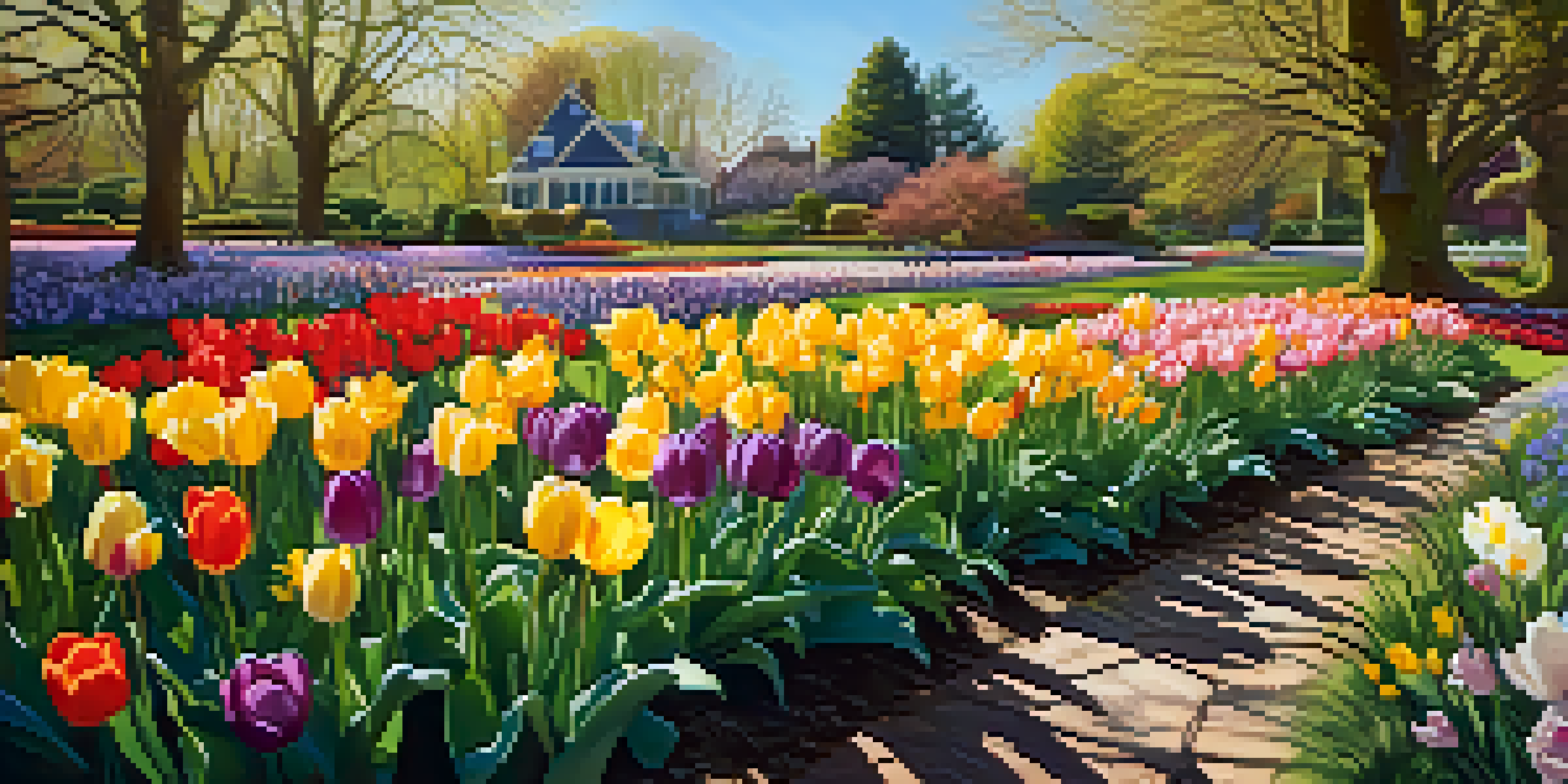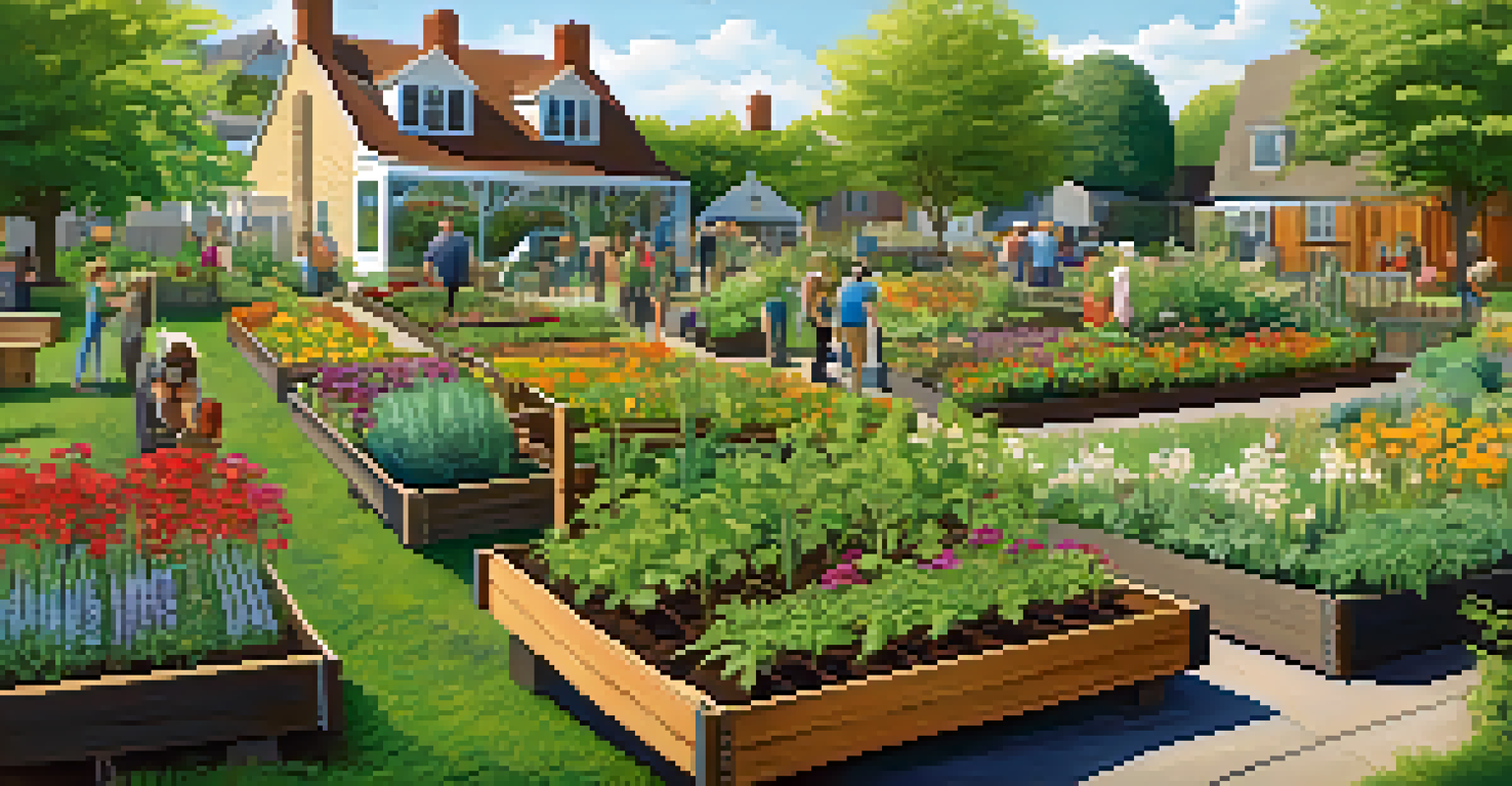The Importance of Seasonal Plants in Sustainable Design

Understanding Seasonal Plants and Their Benefits
Seasonal plants are those that thrive during specific times of the year, adapting beautifully to changing climates. These plants not only add vibrant colors to landscapes but also play a crucial role in local ecosystems. By understanding the life cycles of these plants, designers can create spaces that are not only aesthetically pleasing but also environmentally friendly.
To plant a garden is to believe in tomorrow.
Incorporating seasonal plants into design allows for a dynamic interaction with nature, as gardens and landscapes evolve with the seasons. This shift not only enriches our surroundings but also fosters a deeper connection to the natural world. For instance, a garden filled with spring blooms can transform into a vibrant tapestry of autumn leaves, offering continuous visual interest.
Moreover, seasonal plants are often more resilient and require less maintenance compared to non-native species. By choosing plants that are naturally adapted to the local environment, designers can reduce water usage and minimize the need for chemical fertilizers and pesticides, promoting a healthier ecosystem overall.
Enhancing Biodiversity Through Seasonal Planting
Biodiversity is essential for the health of our planet, and seasonal plants play a vital role in supporting a diverse range of wildlife. By planting species that bloom at different times throughout the year, we can create a habitat that attracts various pollinators, birds, and beneficial insects. This not only helps maintain ecological balance but also supports the food web in our gardens and landscapes.

For example, planting early-blooming flowers like crocuses can provide essential nectar for bees just as they emerge from hibernation. Meanwhile, late-bloomers like asters offer sustenance for pollinators as they prepare for winter. This strategic planting can significantly impact local ecosystems, fostering a rich tapestry of life in our backyards.
Boosting Biodiversity with Plants
Seasonal plants create habitats that attract diverse wildlife, enhancing ecological balance and supporting local ecosystems.
Additionally, seasonal plants can help combat the effects of climate change by sequestering carbon dioxide and improving soil health. A diverse planting strategy that incorporates seasonal varieties can enhance soil structure and fertility, allowing for a more resilient environment that can withstand harsh conditions.
Water Efficiency in Seasonal Plant Choices
Water scarcity is an increasing concern in many regions, making water-efficient landscaping essential. Seasonal plants, particularly those native to the area, are adapted to the local climate and often require less water than non-native varieties. By prioritizing these plants in sustainable designs, we can contribute to water conservation efforts.
The best time to plant a tree was twenty years ago. The second best time is now.
For instance, xeriscaping, a landscaping method that reduces the need for irrigation, often utilizes seasonal plants that thrive in dry conditions. This approach not only conserves water but also creates stunning landscapes that change with the seasons. By selecting drought-tolerant plants, designers can create beautiful gardens that are both sustainable and low-maintenance.
Moreover, seasonal planting allows for a natural rhythm that aligns with rainfall patterns. When plants are chosen based on their seasonal water needs, it not only supports their growth but also reduces the dependency on irrigation systems. This mindful approach to planting can lead to healthier ecosystems and more resilient landscapes.
Creating Aesthetic Appeal with Seasonal Plants
Aesthetics play a crucial role in landscape design, and seasonal plants can dramatically enhance visual interest throughout the year. By selecting a variety of plants that bloom in different seasons, designers can create gardens that are ever-changing, inviting, and beautiful. This dynamic quality can make outdoor spaces more enjoyable and engaging for everyone who experiences them.
Consider a garden that features bright tulips in the spring, lush greenery in the summer, and fiery foliage in the fall. This vibrant progression not only captivates the eye but also encourages people to spend more time outdoors. Seasonal plants can evoke emotions and create memorable experiences, making outdoor spaces feel more alive.
Cost-Effective Sustainable Design
Choosing seasonal plants reduces maintenance costs and enhances property value while promoting a healthier environment.
Furthermore, seasonal plants can be used to create focal points within a landscape. For example, a striking winterberry bush adorned with bright red berries can serve as a stunning centerpiece in a winter garden. By thoughtfully selecting plants for their seasonal beauty, designers can craft spaces that are visually appealing and resonate with the changing seasons.
Seasonal Plants and Local Climate Adaptation
Adapting to local climate conditions is essential for sustainable design, and seasonal plants offer a perfect solution. By choosing plants that are naturally suited to the regional climate, designers can create landscapes that thrive without excessive intervention. This not only promotes sustainability but also enhances the overall resilience of the landscape.
For example, in a coastal area, incorporating salt-tolerant seasonal plants can help combat erosion while promoting a vibrant, thriving ecosystem. Similarly, in arid regions, focusing on drought-resistant seasonal plants can minimize water usage and create stunning landscapes that celebrate the local environment. Embracing local flora is a key aspect of sustainable design.
Moreover, seasonal plants can help mitigate the impacts of extreme weather events. By planting a variety of species that bloom at different times, designers can create a landscape that is more resilient to fluctuations in temperature, precipitation, and other climate variables. This proactive approach can lead to healthier, more sustainable outdoor spaces.
Cost-Effectiveness of Seasonal Planting
While the initial investment in landscaping can be daunting, seasonal planting can be a cost-effective choice for sustainable design. By selecting plants that thrive in the local climate and require minimal maintenance, designers can save on watering, fertilizing, and pest control costs. This long-term approach can lead to significant savings while promoting a healthier environment.
Additionally, seasonal plants can be strategically planted to reduce erosion and improve soil health, which can save on costly repairs and amendments in the future. For example, using ground cover plants in seasonal rotations can stabilize soil and prevent runoff during heavy rains, resulting in fewer maintenance issues down the line.
Community Engagement through Gardening
Community gardens featuring seasonal plants foster social connections and promote educational opportunities for local residents.
Furthermore, seasonal plants can enhance property value. A well-designed landscape that incorporates vibrant, seasonal plantings can make a property more attractive to potential buyers. This added curb appeal can translate to a better return on investment, making seasonal plants a smart choice for sustainable design.
Community Engagement Through Seasonal Planting
Incorporating seasonal plants into community spaces can foster a deeper sense of connection among residents. Community gardens that feature seasonal plants not only beautify neighborhoods but also provide opportunities for residents to engage with nature and each other. This shared experience can promote social bonds and enhance community spirit.
For example, a community garden that changes with the seasons allows residents to witness the growth cycle firsthand, providing valuable educational opportunities for all ages. Workshops on seasonal planting can encourage participation and empower individuals to take an active role in their environment. This hands-on approach to gardening can instill a sense of pride and ownership in the community.

Moreover, seasonal plants can attract local wildlife, further enriching the community's natural environment. By creating spaces that support biodiversity, communities can enjoy the benefits of a thriving ecosystem while engaging in sustainable practices. This collective effort can lead to healthier, happier neighborhoods for everyone involved.
The Future of Sustainable Design with Seasonal Plants
As we move toward a more sustainable future, the importance of seasonal plants in design will only grow. With increasing awareness of environmental issues, more designers are recognizing the benefits of incorporating seasonal plants into their projects. This shift towards sustainability is essential for fostering a healthier planet and enhancing our quality of life.
The integration of seasonal plants into urban design can help mitigate the effects of climate change while improving air quality, reducing heat islands, and enhancing biodiversity. As cities expand and develop, adapting landscaping practices to include seasonal plants will be crucial for creating resilient urban environments.
Ultimately, embracing seasonal plants in sustainable design is not just about beautifying our spaces; it's about creating a harmonious relationship between humans and nature. By prioritizing seasonal planting practices, we can create landscapes that thrive, evolve, and inspire future generations to appreciate and protect our natural world.